|
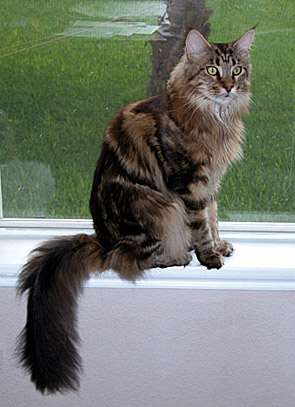
This site is dedicated to the memory of our best friend and most loving companion ....
THORIN OAKENSHIELD
12-11-2002 to 4-8-2005
Let us introduce you to a very special little being, our Maine Coon cat.
Maine Coon cats are the largest domestic breed of cats. The are known for their great intelligence and very sweet nature. They are one of the most popular breeds of cats in the U.S. These wonderful creatures are affectionately known as: *The Gentle Giants*.
The purpose of this site is not only to give you an insight to this wonderful animal, and the breed as well, but to tell his story and inform others of the disease which took him from us, very suddenly, at the age of two years old. This disease, which ripped him from us, without any warning, is called HCM ( Hypertrophic Cardiomyopathy ). It is a genetic disorder (with many variations) defined by thickening of the primary heart muscle: the left ventricle. It is NOT exclusive to this breed-or to purebred cats.
This site is for anyone who has ever had the good fortune to have a very close relationship with their pet....for ALL of you.
Although both of us had several pets in our separate lives, we were recently married, and decided to get our first pet together as a couple. We had been planning to move to a brand new home, where we could offer a good environment for our new little pal. However, we were still living in a very small apartment when our search began.
My husband was a confirmed *cat hater*. Even so, we thought a dog would be a burden at this point. I had met a breeder of these particular cats where I was working. After seeing the pictures of many of her cats, and several discussions, I fell in love with them. I made copies of them to show my husband their incredible size and striking appearance. He decided that if we couldn't manage a dog, he wanted the largest cat we could find. (Maybe something to 'terrorize' those 'woosey' dogs?). Boy, did he get his wish!
This is our little sweetheart in his early days.
As we knew we would be making a rather long interstate trip for our move, Thorin learned to walk on a leash at a very young age. It became his favorite pastime, which he looked forward to daily, once we moved.
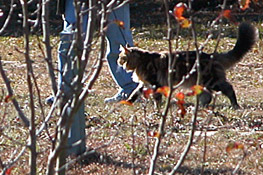 |
| Walks |
In preparation, we outfitted our precious cargo with his own 'travel box'. This would serve him (and us) very well in the many travels ahead of him.
He not only traveled over 700 miles in it to his new home, but 4 trips of about 1500 miles by car, a plane trip at my feet, and another 700 miles back by car. Never a complaint out of him until a cab ride on the BQE in New York! What a trooper!
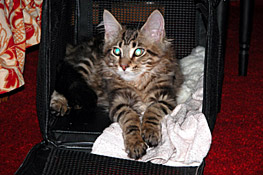 |
| Ready to travel. |
At a few weeks old, I began trying to get him to 'talk' or 'verbalize' in his own cat lingo. Although the breed isn't know for being very verbal, he seemed to pick it right up. Cats can make over a hundred different sounds when they want to talk, and I think he added another hundred to the list. He had a sound and a 'word' for everything. He even had his own 'phrases'. And this from a cat that wouldn't even cry when you accidentally stepped on his tail! What a delightful and ingenious animal.
This boy of ours was quite a character. He was extremely creative and kept inventing new games to play with us. He also had an amazingly 'talkative' tail! He spoke volumes with his eyes and expressions, but that tail!! It held all the extra side comments and expressions that could never be put into words. When excited or annoyed, that tail fluffs up to more than twice it's normal size. By the way, a Maine Coon cat's tail is the same length as it's body. It is an adaptation of Nature, which kept it warm when curled up and wrapped around it's body. When he wanted me to follow him, his tail, held straight up, had a wonderful curve to the end- very much like a little handle. I would take a gentle hold on it, (the curve facing forward towards his body) and let him lead me to what he wanted me to see. It was just another bond we had formed of complete trust and awareness in communication.
Finally, we arrived. He was so ecstatic that he would do high speed racing from one end of the house to the other. There was only one real problem...we had vinyl tarps over the carpet while we were moving and placing furniture, etc. He found that he just couldn't stop on the vinyl, and would go crashing into counters (when he hit the floors) or ramming into the fireplace at full speed!!
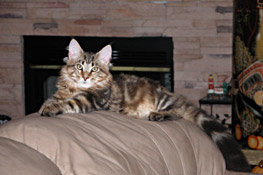 |
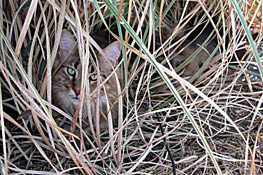 |
| I could like it here |
Can you find me? |
Once the furniture was in place, he began to feel at home.
He really loved his time outdoors and became 'one' with nature.
It was truly amazing to see him jump (from a complete standstill!) half way up the side of the house, just to knock down a lizard to chase. He was excellent at catching butterflies between both of his paws, in mid air. But the most amazing trait of all, was his relationship with birds.
You have to understand, that any outdoor time he had, was on a leash. This was our way of allowing him to address his wilder instincts, while keeping him protected. He was suppose to be an 'indoor only' cat.
But when he saw something he wanted to chase, he would take off running, pulling me behind. This natural hunter (getting larger every day), would walk calmly over to a tree where the birds were, sit down, and watch. Not impressive, I know. But the birds would all slowly move closer to him. They would gather right above and in front of him without fear! The birds and the cat (oblivious to me) would study each other and actually talk to each other. You had to see this cat trying to imitate the sounds of the birds! And he actually 'sang' the sounds pretty well! It was really amazing.
This cat had the ability to steal everyone's heart. He converted many 'cat haters' so completely, that they would not only stop by to visit him, but bring their friends to meet him! In the case of my brother-in-law...we had some severe bargaining occur, NOT to take him home with us! Can you blame him. Look at that face.
In all our travels, and in everything that we did, Thorin was the center of our world. He was the utmost in faithful companions.
When I was preparing things in the kitchen, Thorin needed to sit on his little 'perch' (a box near the entrance), where he could watch what I was doing. Often, if something smelled really good..., he would strut over, stand up on his hind legs, rest one paw on my butt, and hit me with the other to get my attention. He was very intelligent and curious, and really needed to be shown what I was doing or what I had. That went for everything we did. He was usually very satisfied if you just showed it to him.
Sometimes he just wanted a taste. He loved vegetables and a little nibble of fruit. If there were cherries to be had, he would climb up on you and want to take it from you. When we would actually give him one, it wasn't to eat. He just loved to swing that cherry from the stem! He'd toss it and pick it up, carry it around, and swing it from his mouth until the stem finally came off. Then it wasn't 'any good' anymore, so he'd march right over and do his best to acquire another one. It had to be seen...he had us laughing for hours!
Whenever we went outside without him, he would run from window to window to find us and watch whatever we were doing. He would often stand up on the glass doors, on the tips of his hind legs, and use his front paws to swipe on the glass -alternating paws at high speed. We wanted to tie little dustmops on them as he looked like he was cleaning the glass. He never scratched with his nails. In fact, the large tufts of hair between his toes, (that are common to the Maine Coon) looked like 'fuzzy slippers' and softened his touch.
Thorin was very regimented in his schedules...for us AND for him. A typical day would have him walk by the bed a few times, first. If I didn't respond to him, or show signs that I was getting up, he would proceed over to the blinds and start banging them, just enough to wake me up. That's something he developed on his own, to make sure we knew he wanted our immediate attention. Then he would lead the way to the kitchen for me to start the coffee. Then to the back door blinds, for me to open them so he could watch the birds, or let me know there was a squirrel to be chased. If my husband wasn't up by a certain time, he would march himself back to the bedroom and be sure to start beating on the door. That is...unless I didn't close it all the way when I left. He would stand up and use his whole body to push the door open and then either stand up and pat my husband to wake him, or go for the blinds again. Heaven forbid if the alarm went off and my husband tried to catch a few more minutes sleep! Thorin would get very upset if he was late.
When it was time for the morning 'sprucing' routines, he was right there with us. He loved to jump up on the double sink area and just watch all our routines. If I took too long playing in front of the mirror, he would push himself right in front of me, between myself and the mirror!- As if to say,"Ok, that's enough! Let's go.".
After the early routines were taken care of, he would give me some time to myself, while he went to lay across a window sill or do a little playing. But if something was of interest outside, he would literally run from one end of the house to the other, back and forth, from window to door, to window, to follow whatever he was watching. Then you'd better not be in his way. He was about four feet long, including his extended tail-straight out. He had reached 15 pounds, just before he left us. And when he stood up on his back paws, and stretched himself up with his front legs extended, he actually reached halfway up the door! He was a big boy...but definitely not fat.
All bets were off when it was time for his walk. Every method he could devise was put into play when it came to his walk time! First, the pacing..to me, around me, over to 'his drawer' (that's where his leash was), and back again. Then came the cry,"out??". There was no mistaking it. If he saw I was involved in something at 10:30-11:00, he might give me a little bit of a break. But not much. Then he started, "Now?" everytime I moved even remotely in the direction of his drawer.
Finally was the most precious time of the day to him. First checking all his favorite spots, but there was always time to catch a butterfly or hunt down a lizard. As the Maine Coon cats were known for being incredible hunters-usually excellent 'mousers' , I felt he deserved this hunting routine as part of his inherent nature. And he was so good at it-even on a leash. Of course, I had to keep up with him. When he caught a lizard, he didn't chew it or eat it. Instead, he would pick it up in his mouth and carry it to a more open area, where he would drop it on the ground. As they were often chameleon types, it made it easier for him to see it against a clearer area. Then he'd just poke it to get it to scramble. We were kind...if the lizard was very small, or he had been playing with it awhile, I would sneak it away from him, and place it somewhere safe to prevent too much trauma and save him for another day. Then we'd go on to search for others. After all, the 'Hunt' was everything. Just spotting them was hard enough. But to actually chase it and capture one, was most of the fun.
The walk was the big event of the day, and once satisfied, he would be quite contented to relax most of the rest of the day. Unless of course we were outside for him to watch.
We usually gave him specific playtime before and after dinner. When it was time for HIS food, he gave the same signals-maybe different 'sentences'. But if all else failed- the blinds were called into play. Then he could relax while we did. BUT!... if we stayed up too late for his schedule, he'd let us know.
One of his funniest routines was that he wouldn't drink from a water bowl on the ground. He absolutely insisted on drinking from the bathroom sink. At first it was just from the sink filled a little with water. But then, he wanted to drink from the running tap! This was a big cat to be sitting up on the sink! And he wouldn't keep his mouth at the water, either. He would dip in, get a little in his mouth, and then sit back up and lap it into his throat, before going back for more. He was determined to have it his way. He would come to get us to give him his drink, whenever he needed it. We had to put his water bowl up on the counter between our double sinks for when we weren't available. That was acceptable. We did try one of those cat fountains-with the running water, but he refused to use it. Even though it was very quiet, he did not like any sounds of a motor running.

We hope we've given you some insight into the personality of our Thorin. He taught us something new every day we had him. He gave us all of his love and attention and captured the hearts of everyone who met him.
On his last day, he played and romped, and visited quite a while with his friends-the birds. Then sat on the window sill and watched 'his mommy' plant some flowers outside. When I called him for his dinner, he came running. He went over to his bowl, took a bite, and fell. He tried to get up, but his back legs wouldn't go, and he fell completely down-eyes open. I ran over to him as he drew his last breath in my arms. -but I didn't realize that was it. I tried to revive him, checked his throat for any food he may have choked on, and tried little chest compressions. I had no idea what had happened to him. I tried putting a straw, very gently into his throat, to breath air into him. Meanwhile, my husband as hysterical and shocked as I was, tried to get someone on the phone to help. In all the emergency of the situation, we traded places and I tried the phone. We had no idea who to call on a Friday night. The one service we got, had a women who simply said to me,"so your cat's dead, then?" I just yelled, "well I hope, NOT!- Isn't here anyone there that can help me??!" Apparently, there are no emergency animal services-or vets for that matter, to be had in this area. We would've had to travel 40-50 miles north or south to try to get someone.
Here was this huge, very long cat, in my arms, completely limp, and I was still worried about making sure I supported his neck so I wouldn't break it. It all happened too fast. We didn't have enough time together. A mutual friend of ours was at my door within minutes of calling for a possible phone # for help. I never knew how good a friend she was until then, as I hadn't known her very long. We just stood there, knowing it was over.
There ARE no words...there is no consolation that can make me forget those last few minutes of utter helplessness. That is why we have started this website.
We have found out ALOT of information since then. We hope we can pass it on to those who are interested in finding out more.
First and most importantly, HCM is NOT exclusive to the MAINE COON CAT breed. It has been diagnosed in many Persians, RagDolls, and others as well. It is only singled out as APPEARING TO BE prevalent to these breeds, because these are the breeders who are doing the most to try to trace, document, and prevent carrying the genes on in their lines. HCM is MORE common in the average feral, tomcat and stray, as they can interbreed more rapidly. I've also been told that there is a viral version which can be picked up and carried on-more easily in these outdoor cats.
Secondly- there IS testing that can and should be done. Part of the expense of buying a purebred cat from a breeder, is the assurance that they have done the proper testing and avoided the inbreeding with infected lines that can lead to the continuation of genetic diseases. A breeder should be TELLING you if they have had these problems in their line! YOU SHOULD BE ASKING!!! 1). If they've HAD the problem and 2) if they have DONE the testing-and CAN PROVE IT!!.**Be sure the parents and grandparents were tested clear. With kittens, it is tremendously hard to detect, but the best bet would be to have them checked at 1 1/2 - 2 yrs. old and then perhaps yearly until about 4. However, check that suggestion with knowledgeable vets and breeders- of which I am neither.
There's lots of info out there- I don't have it all. Check some of the links- I will add to them as I find additional information. But know that it's still "If-y". Cats can be tested negative and still die. Others can be tested positive and live to a ripe old age, or never have had it. It must be an experienced Vet (preferably board certified for these procedures) with specialized equipment for this purpose. Also, I have heard that some Vets are very quick to diagnose HCM for anything they can't explain...so be aware of that.*
Although some disagree that HCM can be diagnosed and treated successfully to extend the life of the cat, I have spoken to several who are doing just that. The encouraging news is that there is a NEW type of testing (DNA), just recently developed, which seems to be rather promising. This would make it very simple for testing with pretty accurate results. It's coming- but I can't say when.... so keep asking! *UPDATE NOTE: It actually IS being used, and alot of breeders have been helping the research effort by having their cats tested. However, at this stage, the results have not been quite as accurate as they had hoped. In fact, they may have opened 'Pandora's Box', as it seems there may be several different genetic strains, which need more individualized tests to determine.
* I did learn an interesting little fact... An early X-Ray, can actually be used to help identify the affected heart. It seems that a heart which is deveoping the thickened condition, usually related to HCM, shows more of a 'Valentine' heart shape. This may be a more inexpensive way to get an idea if you may need to due more detailed testing.
We were never told about this disease- and NO INFORMATION about it was offered. Some feel that they will unnecessarily frighten prospective buyers- because it is such a scary disease. Apparently, it can skip several generations before it rears it's ugly head. On the 'up' side, it CAN be detected AND treated , if caught soon enough. Usually, it can be detected prior to seeing any symptoms, (in our case- we never saw or recognized any), but there's no guarantee if they test negative. It has been known to be treated and extend the life of the cat for many years, but obviously, this varies with each particular case. It's just to nice to know that some hope does exist. We had no idea.
Thorin had the nastier version, that takes them very young. Most cats aren't even diagnosed with it because it hits them when they are much older, and most of us figure it was 'just their time'. So more often than not, the cats are never tested for it at that point, and it's therefore, overlooked. We couldn't even imagine WHAT could've happened to our 'baby' and had to have a necropsy done. We didn't know if he was somehow poisoned, got fertilizer on his paws, or ate something we didn't see. That wouldn't have been very much like him, but we HAD to know if it was somehow our fault-our ignorance, or our carelessness. We were told that it is THE MOST COMMON CAUSE FOR SUDDEN DEATH IN CATS! The breeders I have spoken to say it was the right thing to have the necropsy done. This is to confirm the diagnosis. Once that is determined, the breeder(s) should be notified immediately. 1) to let any others with kittens from that litter, be told. 2) The breeders will usually-either immediately have the parents neutered to prevent the genes from continuing any further or completely remove them from any breeding program., and 3) They will usually make arrangements for replacement of the cat (in this case, because he was only 2 years old) or reimburse you for another one.* This is NOT to give the impression that breeders will replace them for an indefinite period of time. But most reputable and conscientious breeders will do this, as they are completely aware of the devastating effects of this disease, and they love their cats and the breed.
**AN IMPORTANT NOTE: The breeder that we got our cat from-and the 'very reputable' breeder who recommended her, (and had her own litter we could've chosen from at the same time- in the same place) gave their "Gee, I'm sorry's" and that was it. Neither are breeding now (-or so I'm told)......! And no effort was made to replace (they usually have connections w/other breeders, and will often exchange favors for prior or later situations) nor even partially reimburse us. (In this case, they no longer expected any litters to be working with). It was treated as though it was a shame, but these things happen. Our breeder never even thought it deserved any further discussion. They both knew very well about this disease, but never even mentioned it to us. And the more well-known breeder, spoke as if we were very naive not to know about it. She mentioned that I read her article about 'finding a kitten', -as if that told it all. By the way.....there was absolutely NO MENTION of HCM anywhere in it. I relied on HER and her 'reputation' to inform ME about it, as we were 'this close' to chosing one of hers, instead. We were told so much information, we didn't know what was being 'left out'. So we actually felt confident that we were being well-informed. So much for recommendations and 'reputation'.
I WILL mention this as advice! Don't go running to the first breeder you find! Just as these breeders will want to interview YOU, you should be grilling THEM. From what I have learned to this point, the general concensis is, that breeders feel YOU are obligated to investigate and find out all related information BEFORE you contact them! ASK about their health contracts and WHAT that covers-for how long. With all the previous experience I had with many animals other than the dogs and cats, I thought I had a pretty wide collection of maladies under my belt. Even though I had raised quite a good number of kittens, I still didn't know what I wasn't familiar with- to ask about. (Also, I didn't have a computer at home then, and couldn't spend that kind of time on it at work to do that research. But if you're reading this- YOU can! As I mentioned before...it's hard to research what you don't know about!) Each breed has it's own specific issues. ASK them what they think you might need to be aware of in health, temperment, dietary issues, home environment, or special needs. So if you haven't done enough research, ASK them what the specialized problems with their breed are and then go do more research. When you feel you are armed with all the facts...go back and ask them what THEY know about them. If certain things are 'brushed off' as unimportant, or you don't get satisfaction that this person has enough familiarity with any of your issues...they're probably not the one you want to deal with. *Additionally, don't rely on only your own opinion of the breeder. ASK for references- of other breeders AND those who have gotten pets from them. All too often, they are very good sales people and can have 'wonderful' websites, touting their fame and accomplishments, but if you ask around...you may be told to "Run as fast & as far away as you can"! So check those references! And find others in the same associations to ask about them.
**PLEASE NOTE: Our Thorin has NO CONNECTION to OAKENSHIELD'S MAINE COONS in The Netherlands. Gregor Bekker is a strong proponent for testing and keeping his lines healthy. We would like that point to be clear.
We will be happy to answer any questions and comments you may have either about the site, our Thorin, or the disease, HCM. We are working to add links to information you may want, but it's been a challenge just getting this far. Please feel free to contact us at ourmainecooncat.com. (Use the link on top of the page.)-And PLEASE! Feel free to give us your COMMENTS (also a link at top of this page) if this page has helped you.
We're interested in what you think of this site.
THANKS FOR LOOKING!!
|